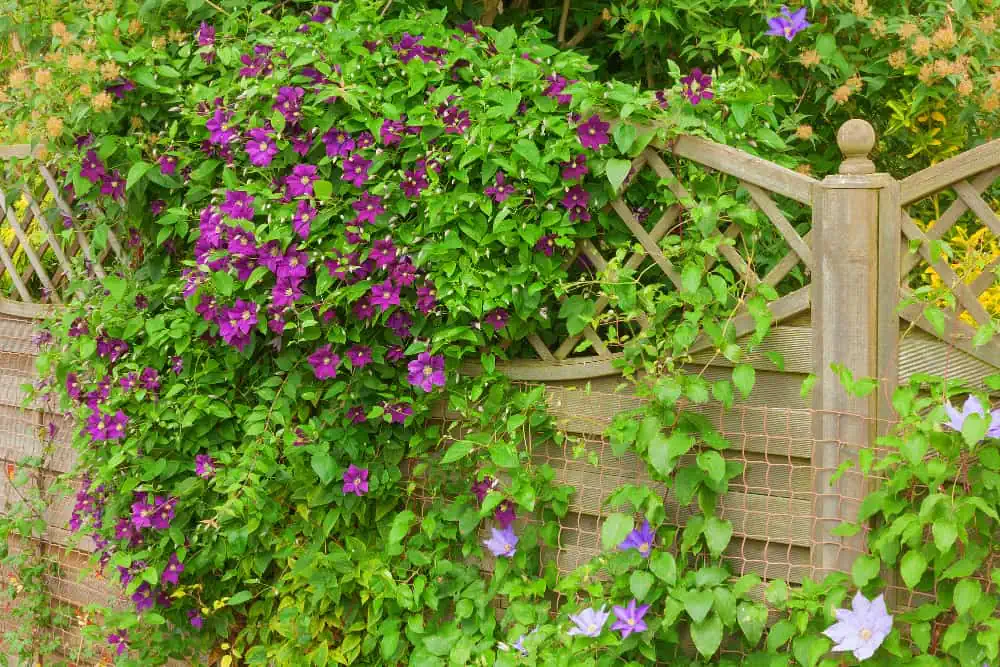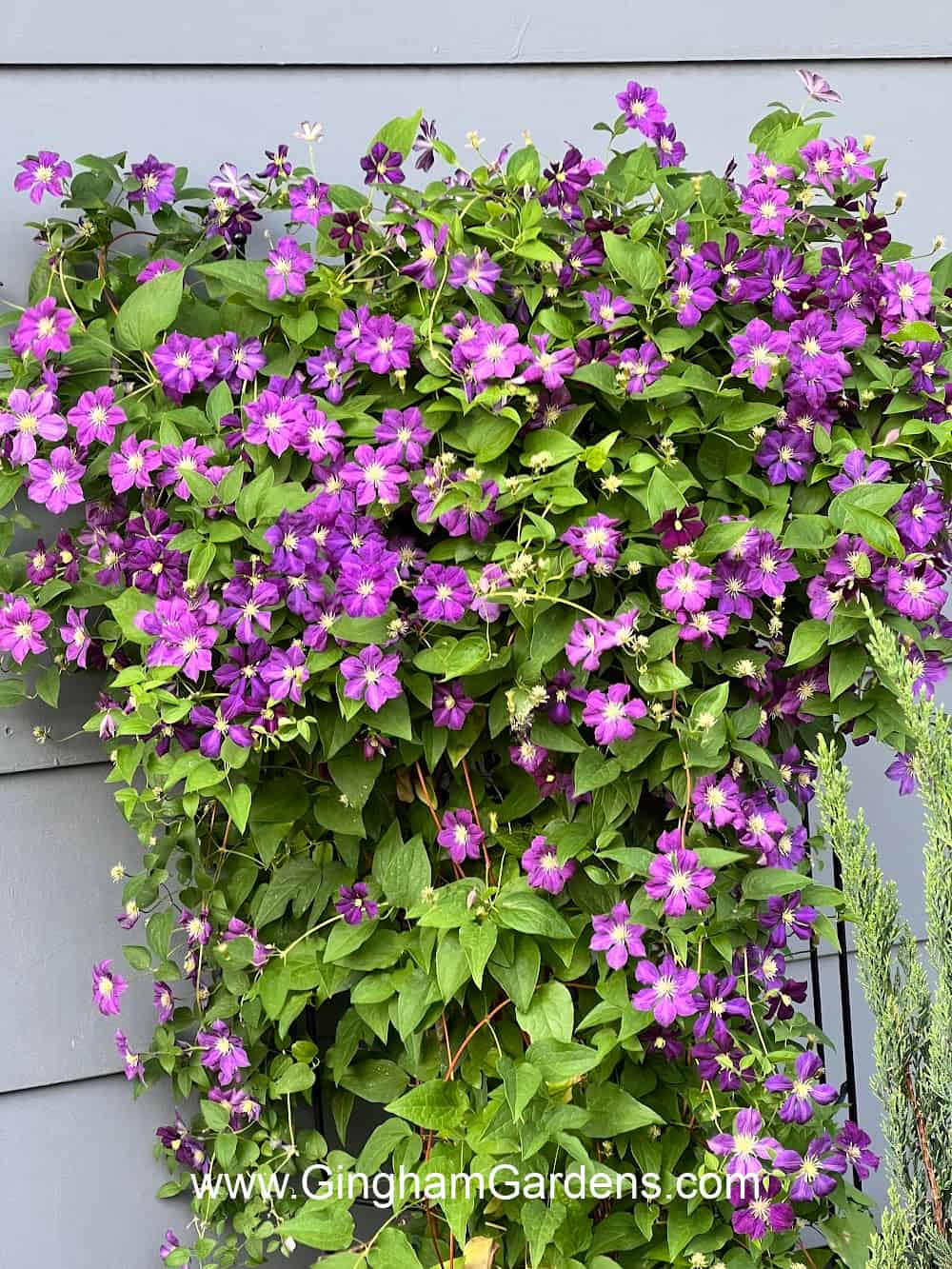Growing Clematis (the Complete Guide)
Clematis are amazing, gorgeous perennial plants that are either in a vining or bush form. There’s just nothing that makes a statement in the garden or your landscape like a clematis growing on a trellis or arbor. In this article, we will be covering all aspects of growing clematis for the average home gardener.
There are many reasons to grow clematis; including, but not limited to:
- They can provide vertical interest to a garden space.
- Since they are perennial plants, they will continue to grow and get bigger every year.
- Clematis are easy to grow.
- There are lots of varieties with diverse flower shapes and colors.
- Oh, and did I mention how beautiful clematis blooms are?
This post contains affiliate links. If you click on
one of the links and make a purchase,
I may receive a small commission at no additional cost to you.
See full disclosure here.
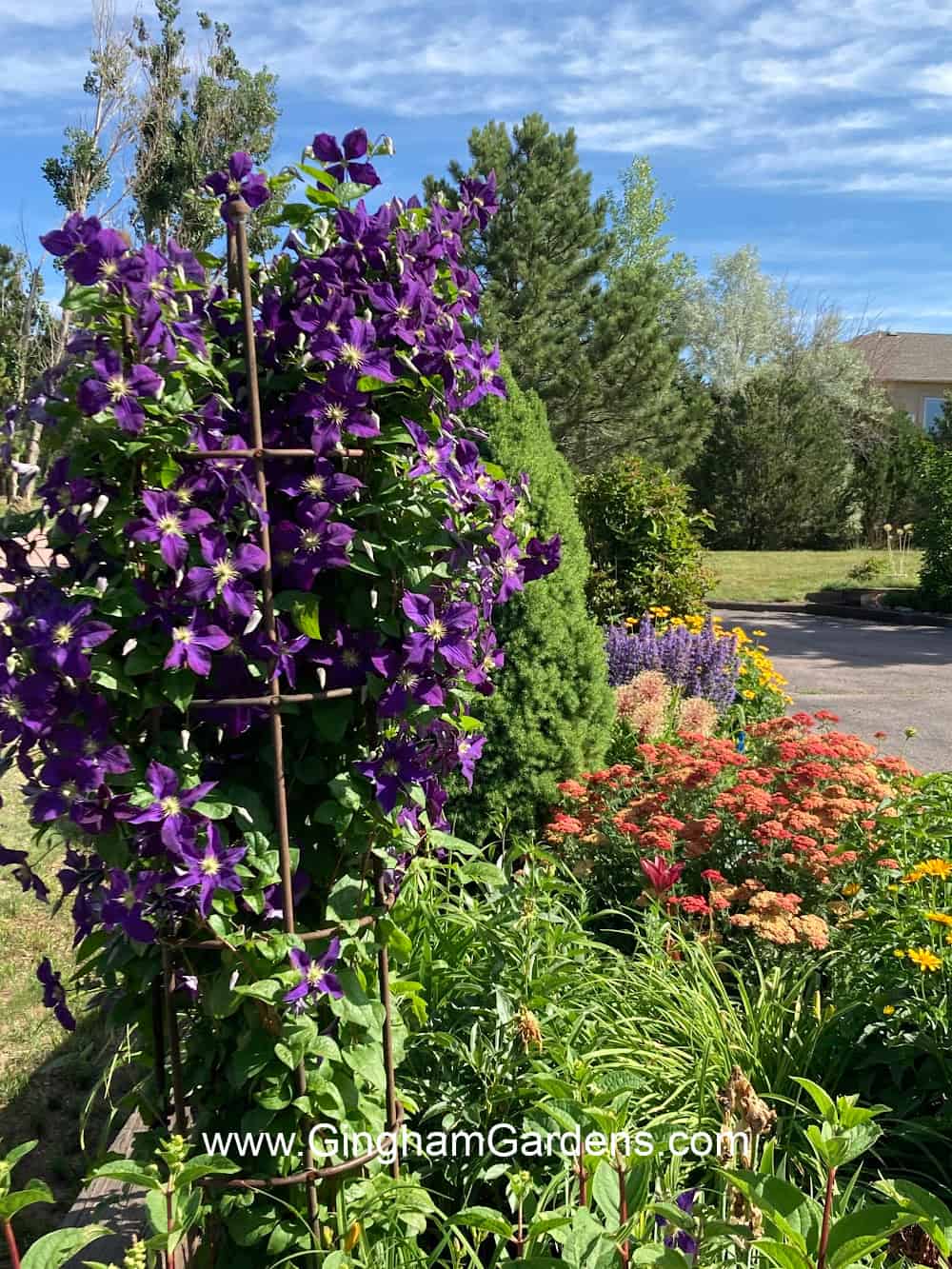
Things to consider before you purchase a clematis.
Do you want a fast-growing clematis? If so, do your research before you purchase. There are many fast-growing clematis vines. The fastest growers in my gardens are Sweet Autumn, Jackmanii, and Warsaw Nike. While others take years to become established and take off.
Also, think about where you will plant your new clematis plant. Clematis like 6+ hours of sunlight a day, but some varieties will do fine in partial sun or partial shade with 4-6 hours or direct sunlight a day. There’s a saying about clematis that goes like this, “head in the sun, feet in the shade.” In other words, the top of the plant needs full sun and the bottom root system needs to be in the shade. It’s easy to shade the roots by planting another perennial in front of the clematis. Clematis also benefit from mulching.
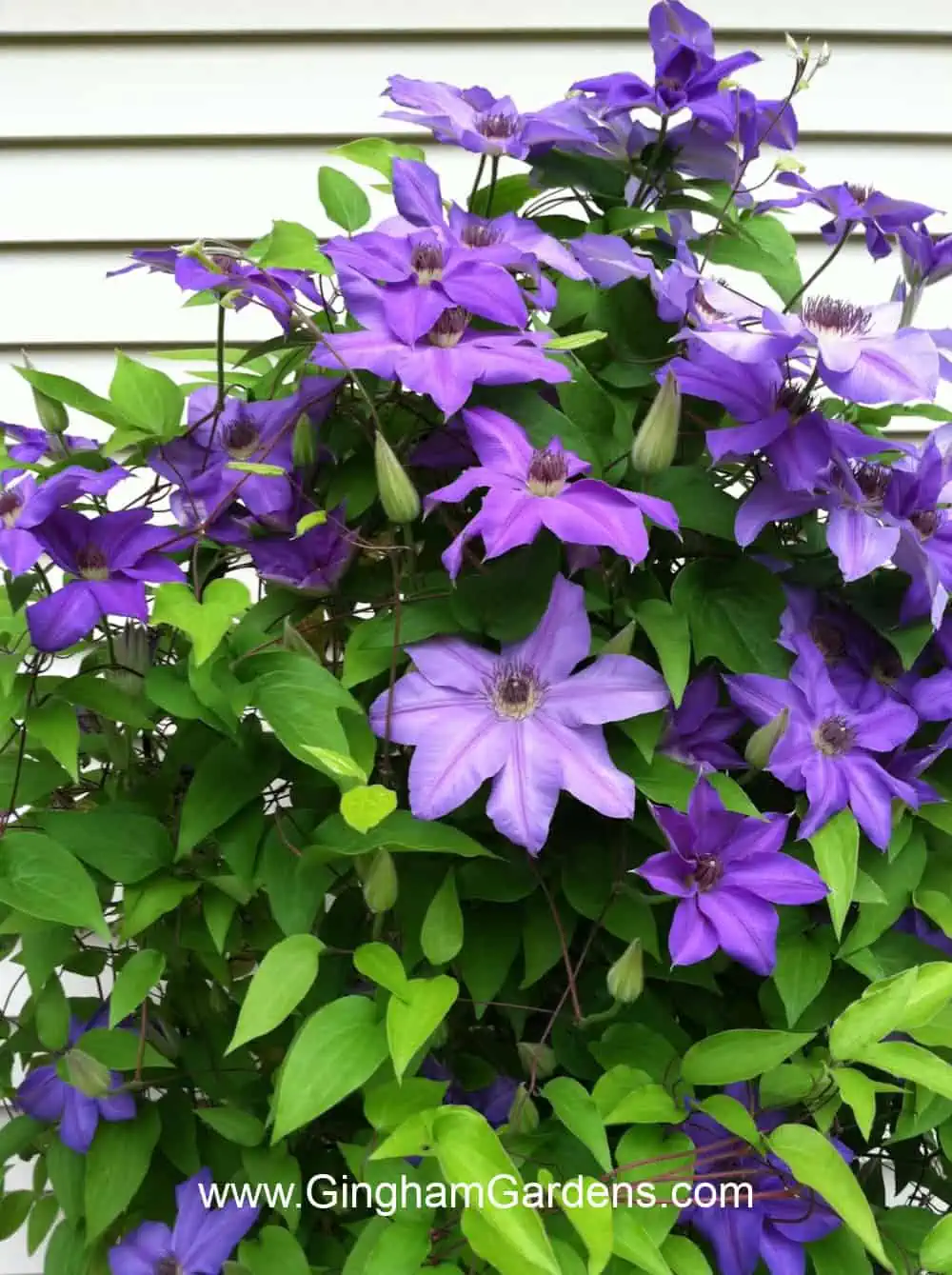
It’s important to have an idea of what variety you want before you go shopping, so do your homework. If you have pets, please note that some clematis plants may be toxic to dogs and cats. Do your research!
Some clematis vines need help when growing on a trellis. While some varieties have tendrils that will catch on, others do not and will need to be loosely tied. Shorter varieties of clematis, or those with a bush type growth habit, look amazing just meandering through the garden amongst other perennials.
Know exactly what structure you want your clematis to climb on. It’s important to have the arbor, trellis, or whatever you want your clematis to climb on in place before you plant. Below are some ideas of structures to grow your clematis on. The stems and tendrils on a clematis can be very fragile and will break easily. Don’t worry about a broken vine though, just snip it and move on. A broken vine won’t damage the plant.
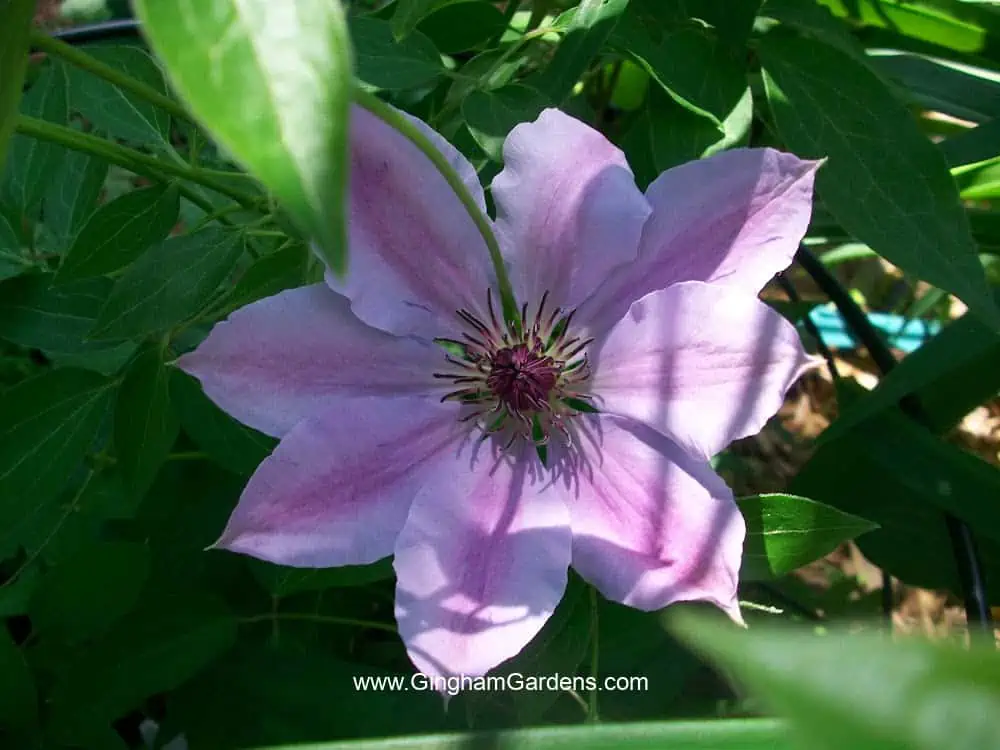
How to Plant a Clematis
Before you even start digging, read the label that came with your clematis thoroughly. Those plant labels contain important information. Remember the best time to plant new perennials is early morning and preferably on a cloudy overcast day.
Dig a hole about twice the size of the pot. What is the soil in your garden like? If it’s sandy or clay-like, it will benefit your new plant to mix in some rich organic matter like compost. If the soil is particularly dry, fill the hole with water and leave it for about 10-15 minutes, or long enough that the water soaks into the surrounding soil.
Next, gently tug the plant from the container, by squishing in the sides of the nursery pot and gently shaking the upside-down pot with one hand while holding your hand around the soil and plant with the other hand.
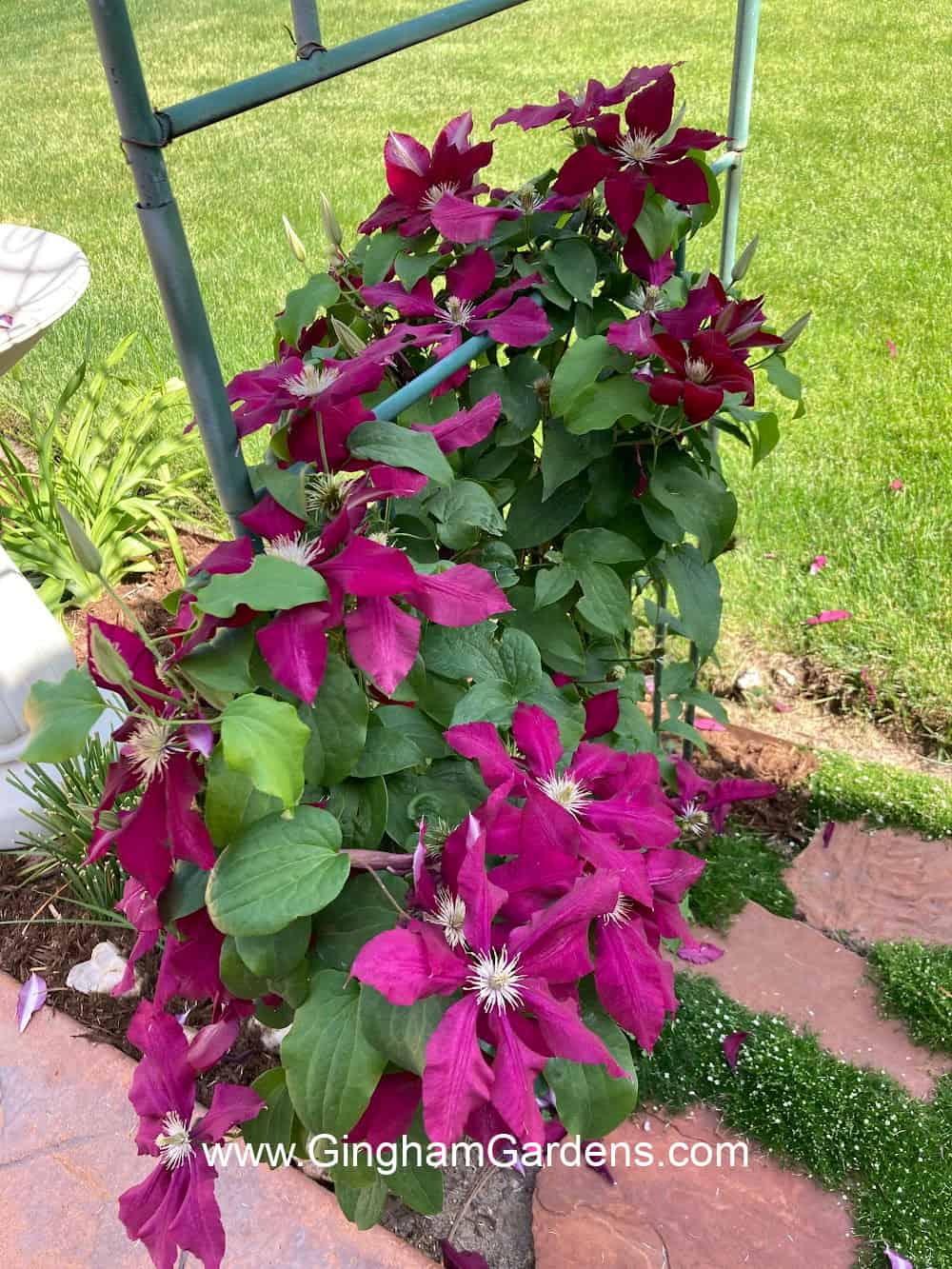
After you have the plant out of its pot, rough up the root ball a bit. The idea of roughing up the root ball is to get the roots to spread out in their new home.
Place the plant in the prepared hole, keeping the crown of the plant at ground level and backfill with the existing soil and good compost.
There are mixed bits of advice about how deep to plant clematis. Some say to plant deep (the buried vine will establish new roots) and some say to plant a clematis at the same soil level as it was growing in the pot. I tend to go with the second school of thought.
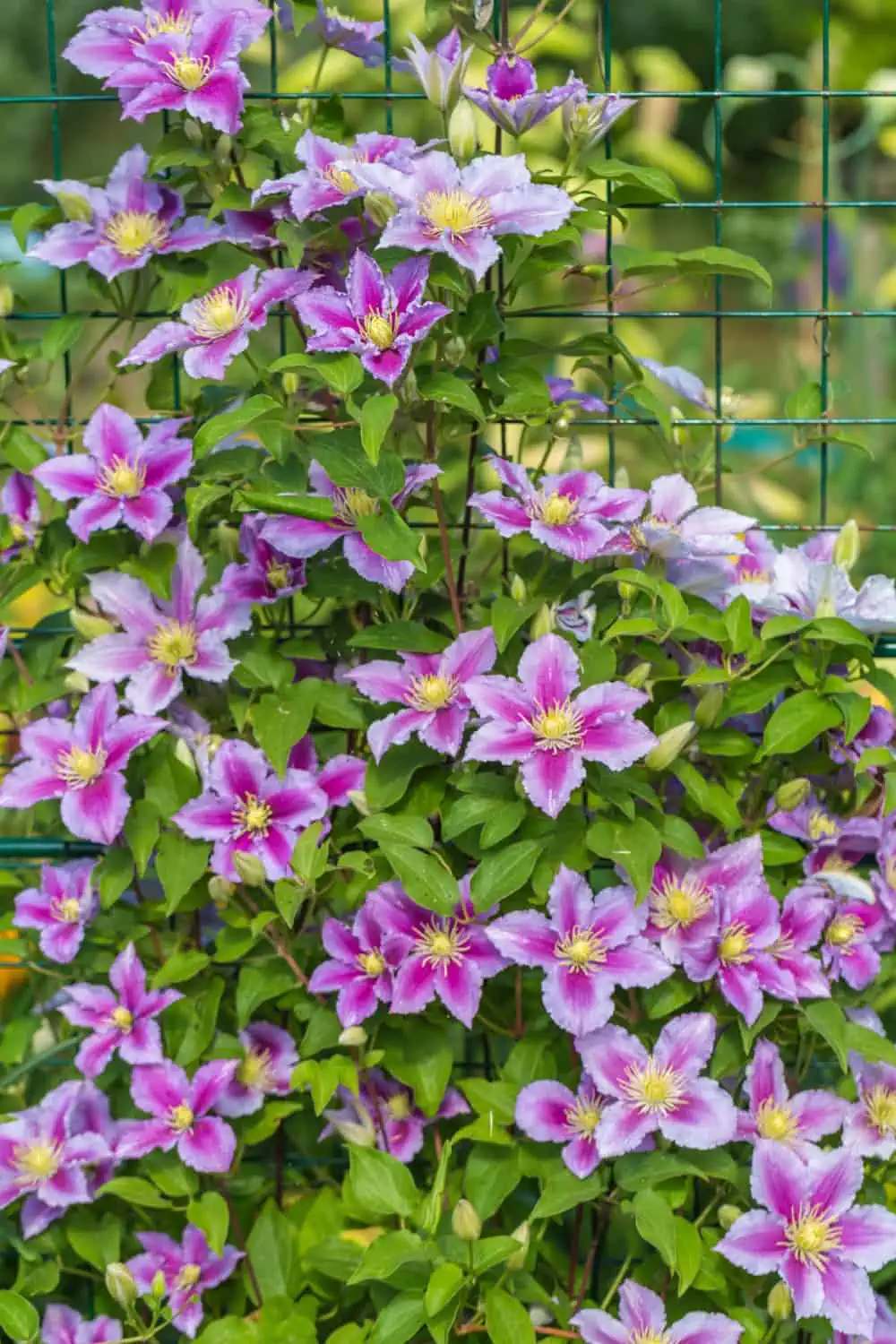
Once you have your new clematis planted, cover the soil surface by adding a couple of inches of a good shredded wood mulch around the base of the plant. That helps the plant retain moisture and the mulch helps to shade the clematis roots.
Just a bit of gardening geek advice, be sure to mark your new clematis with a plant label, so you remember its name.
Clematis Care
It’s important to note that clematis plants simply do not tolerate dry soil. They will die very quickly if they do not receive adequate water. When watering, water at the base of the plant. The roots benefit from water and not necessarily the plant itself, so give the plant a deep soaking. If you are unsure of how long or how often to water, a soil moisture meter is a great little device to have. It is especially essential for your new plants to receive adequate moisture during their first year.
Clematis will benefit from a slow-release fertilizer early in the spring. If I remember and have the time, I will also fertilize in the fall. A commercial fertilizer can be used, or your plant will also benefit from a layer of compost. This is a great organic fertilizer for perennial plants.

What are Clematis Groups
Clematis cultivars are divided into 3 groups. Determining which group your clematis falls under is how you know when to prune your clematis.
Group 1 – Spring bloomers on old wood. They really require no pruning at all in order to bloom the following year.
Group 2 – Late spring or early summer bloomers on old wood. Varieties in Group 2 can be pruned after the first flush of flowers and if you’re lucky, you’ll get a 2nd bloom on new wood.
Group 3 – Late summer bloomers on new growth from the current growing season. These can be cut down in late winter or early spring to about 6 – 18 inches from the ground.
If you have the name of your clematis, but don’t know which group it falls under, do a google search.
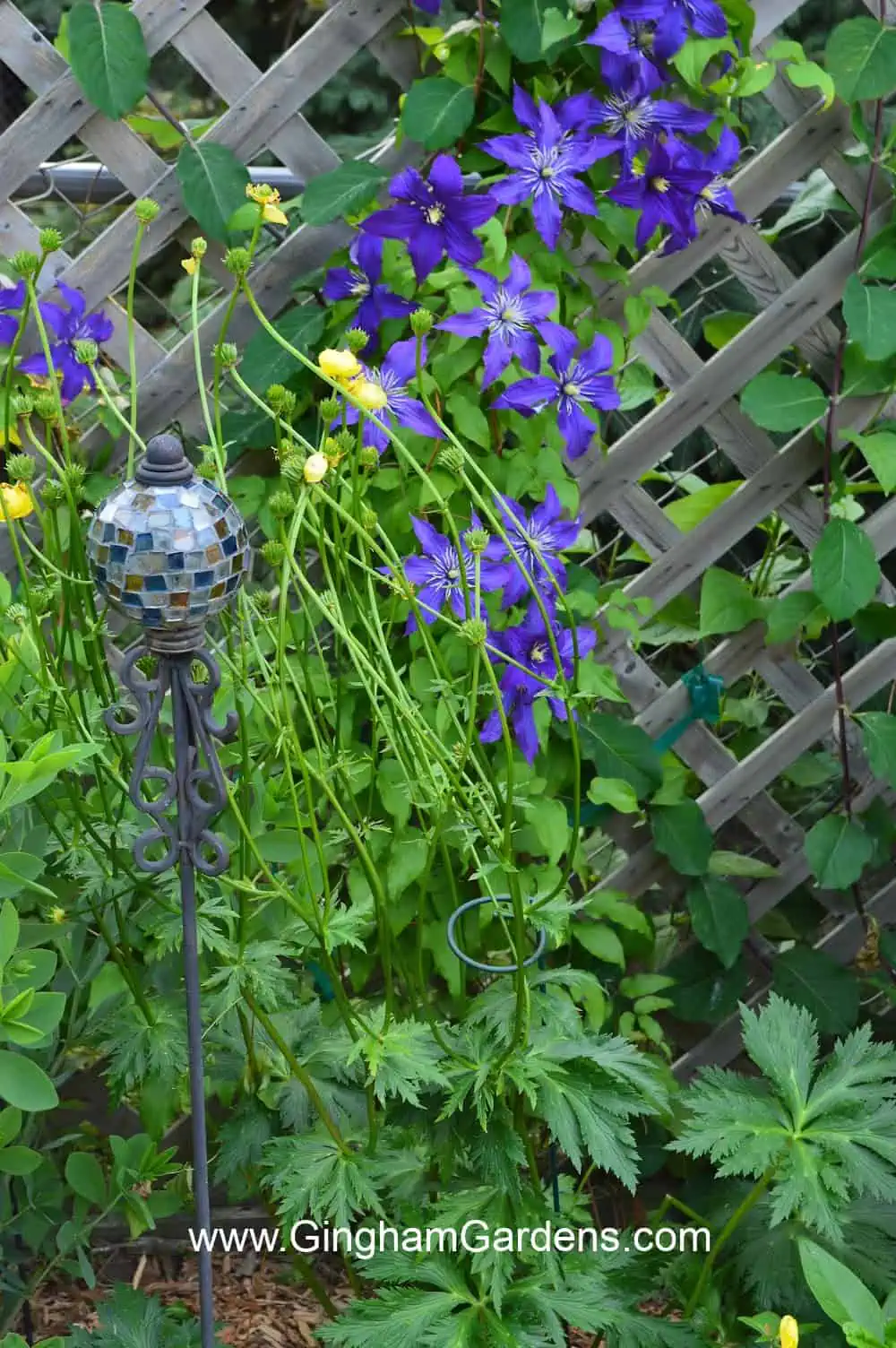
Ways to Identify Your Clematis Variety
There are thousands of different varieties of clematis. Oftentimes tags are lost, you inherited the plant with a new home, or you just never had an identifying plant tag. In any case, here are a few ways you can determine what variety of clematis you have.
- The simplest way is to simply google the color of your plant plus clematis and see what comes up.
- Another possibility is by downloading the Google Lens app on your phone. You might just get lucky. There are also plant identification aps, but I have not had success with them identifying clematis varieties.
- Do some digging on Facebook and see if there’s a clematis identification group.
Sometimes, you may just need to observe the growing habits of your clematis to at least determine when it blooms. Also observe the stem structure, is it green or is it woody. With the chart above, you can usually determine what Group your clematis falls into and when it should be pruned.
The image below is a beautiful example of an unidentified clematis. It was one of the treasures left by the previous owners of our home. I love all the gorgeous shades of violet in this plant. I haven’t had time to do the research to find it’s name, but I’m okay not knowing.
Pruning a Clematis
This is the part of growing clematis that makes gardeners shy away from planting them. As you can see pruning your clematis goes hand-in-hand with knowing which group your clematis falls into.
- Group 1 clematis varieties can just be ignored when it comes to pruning, unless there are dead stems or diseased growth, or if you want to control its height.
- Group 2 plants can be pruned after they have finished blooming and you just might get a second set of blooms.
- The late summer bloomers are Group 3 clematis and they can be cut down completely leaving only 6 – 18 inches of vine at the bottom, in late fall or late winter.
So to keep pruning a clematis as simple as possible, here are some helpful tips. Have you ever given another plant in your garden a haircut? It’s basically the same thing when you prune a clematis. With my Group 2 clematis varieties where I’m hoping for a rebloom, I simply cut off the old spent blooms from the current season’s growth. And, if the clematis has outgrown the structure it is growing on, I will cut the top of it back and shape up the stragglers. You can also cut out any dead branches.
Certainly don’t get all freaked out about pruning your clematis. I don’t always get around to pruning my clematis at the appropriate time and often our resident rabbits will prune the clematis for me every winter. My clematis vines always come back the next year. I have never lost a clematis to improper pruning.

Growing Clematis in Pots
Yes, both bush and vine varieties can be grow in pots. The important things to remember when growing clematis in containers include:
- Go with a very large pot.
- Remember plants in containers dry out quicker, so adequate moisture is a must.
- When selecting a clematis to grow in a pot, choose one that is one zone colder than your gardening zone. For instance, if you are in zone 5, select a clematis that is hardy to zone 4.
- If you live in a colder climate, it will be necessary to either move the pot into an unheated garage, or bury the pot in your garden. As an alternative, you can remove the plant from the container and plant it in your garden.
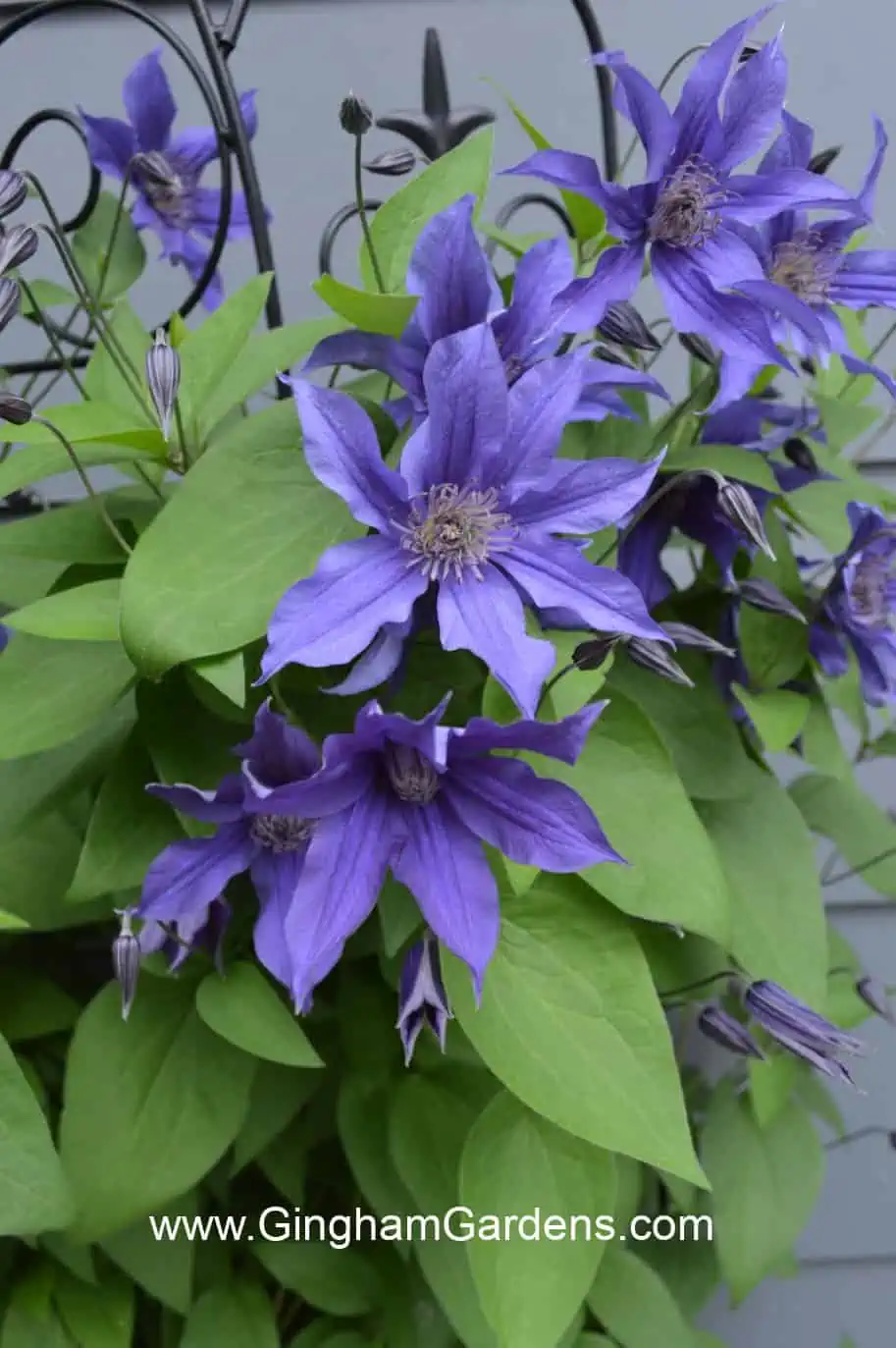
Popular Varieties of Clematis
Group 1 (spring bloomers) Popular Clematis Varieties
- Rosy Pagoda – pretty pink clematis vine with nodding head flowers
- Frankie – pretty lavender flowered clematis that blooms in Spring
- Markham’s Pink – clematis plant with gorgeous bright pink flowers in spring.
- Blue Bird – another spring bloomer with a light fragrance. Blue bird has nodding periwinkle colored blooms.
- Snowdrift – beautiful, lightly-scented pure white flowers cover this prolific blooming clematis vine.
- Elizabeth – this clematis vine is covered with light pink, 4-petaled flowers with a light sheen to them.
- Tetrarose – pretty spring clematis with small, 4-petal, pink flowers with a light spicy aroma
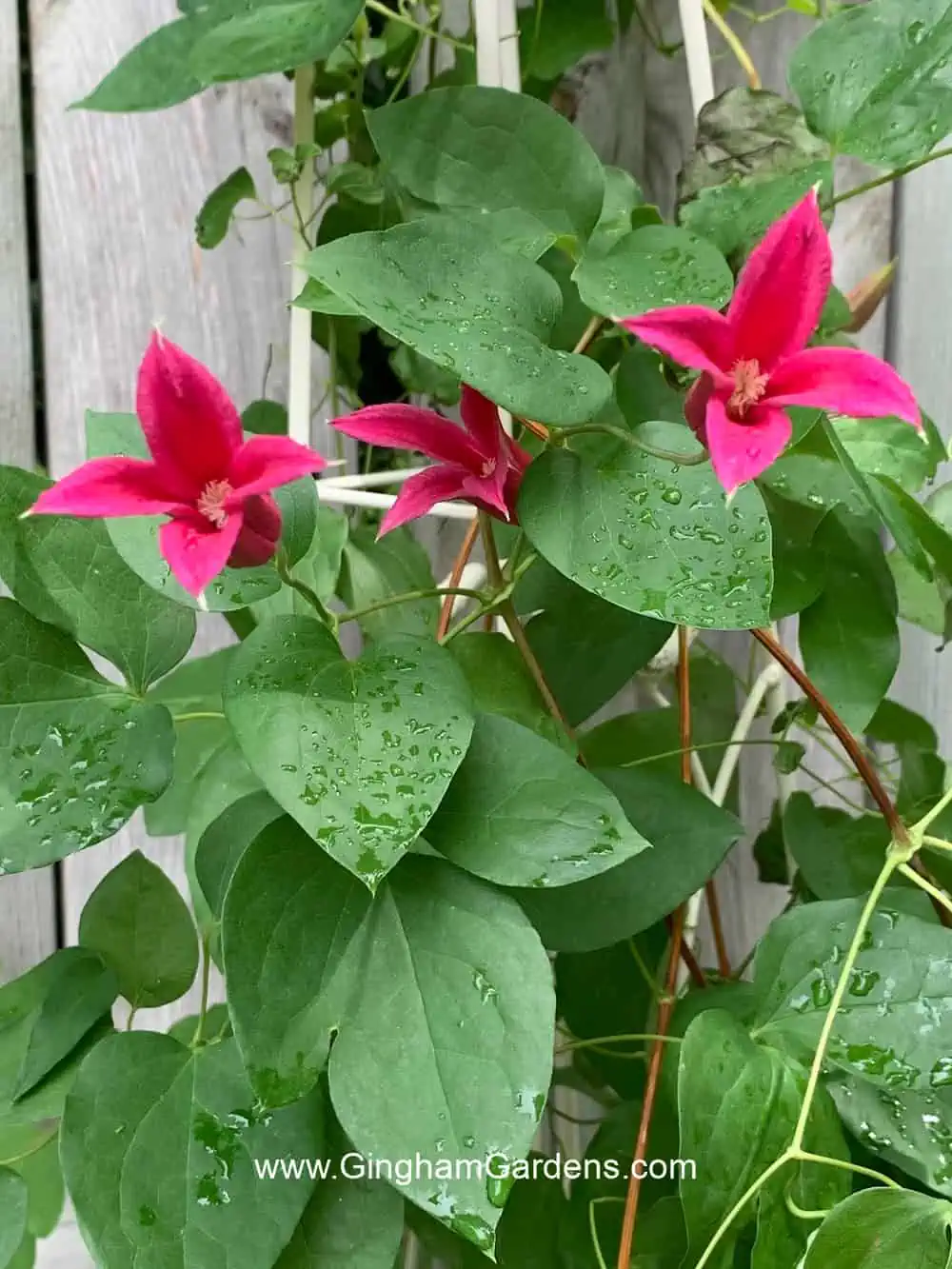
Popular Group 2 Clematis Varieties
- Sapphire Indigo – see the picture above
- Bourbon – a shorter variety with big, intense flowers
- General Sikorski – the seedheads on this one are almost as beautiful as the flowers
- Warsaw Nike – see the picture above
- Ramona – my favorite clematis ever. Unfortunately she resides at our former home. This clematis is considered group 2, but can also be pruned like Group 3, if you want to delay the blooms.
- Rebecca – as with many clematis, depending on the sun and the makeup of the soil, this clematis’ color can range from bright red to a deeper magenta color.
- Piilu – see the picture above
- Abilene – bright pink blooms. See picture below.
- Nelly Moser – see the picture above
Group 3 Popular Clematis Varieties
- Princess Diana – see the picture above
- Duchess of Albany – bell shaped flowers that start to flatten out as they age (see the picture above).
- Jackmanii – probably the most popular clematis of all time with deep purple flowers and the one we see the most.
- Sweet Autumn Clematis – be careful with this one, it can be very aggressive and a very vigorous grower. It may be considered invasive in your gardening zone. I tame mine by cutting off chunks during the summer.
- Ernest Markham – Such a beauty with large, vivid magenta flowers.

Trellises and Structures for Clematis to Grow On
It’s important to have something in place for your clematis vines to grow on. Some ideas include:
- Fences – one of the best ways to cover an unattractive chain link fence is with a fast growing clematis.
- Trellises
- Obelisks
- Arbors and Arches
- DIY garden structures made with tree branches.
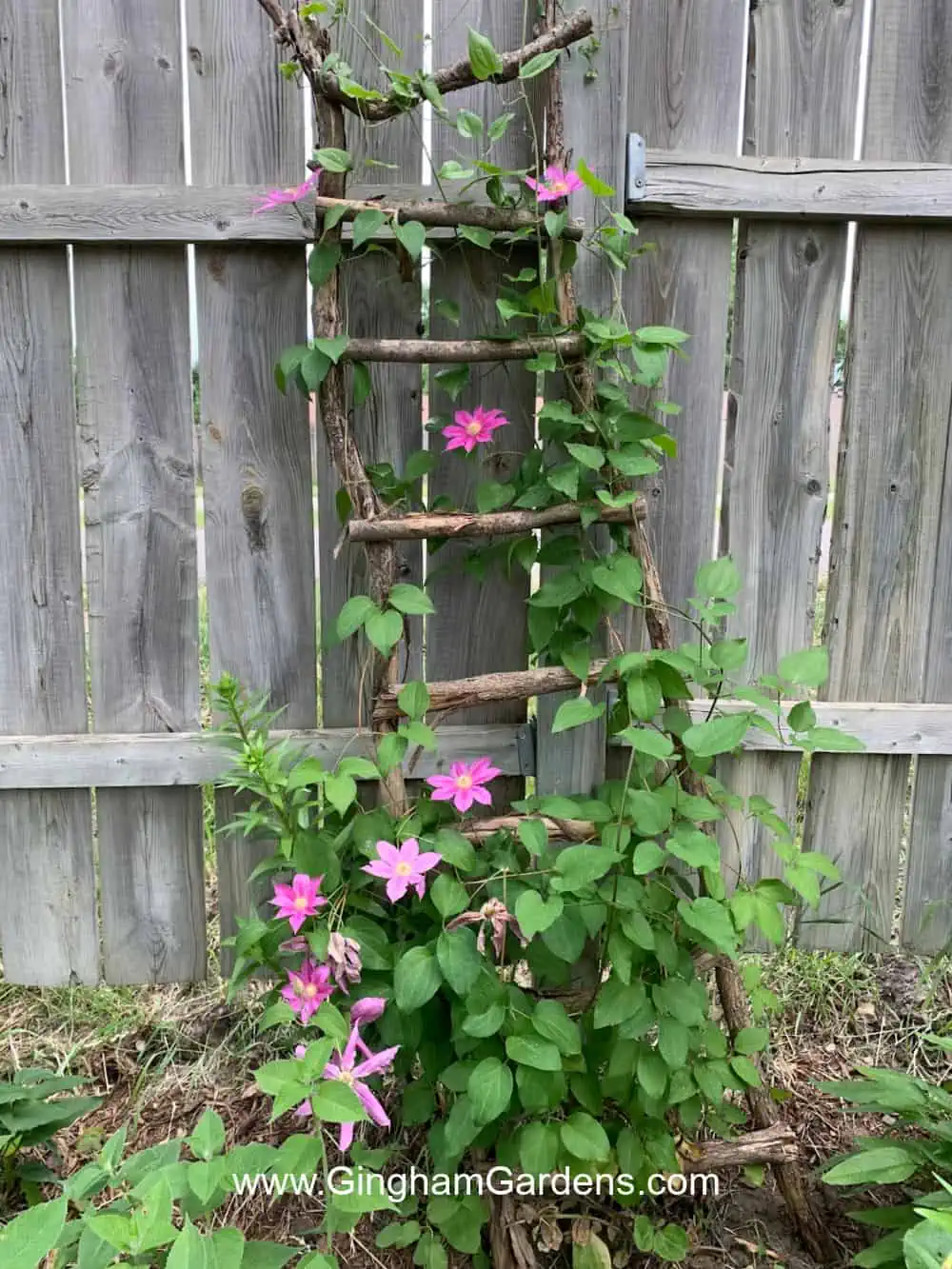
For more climbing plants for your flower garden, be sure to check out Easy to Grow Flowering Vines.
If you don’t have a clematis in your gardens or landscape, I hope I’ve inspired you to add one. Do you have a clematis plant or two growing in your flower beds? Have you ever grown clematis in a container? We’d love to hear your experience below in the comments section.
Happy gardening,
Joanna
More Great Things on Gingham Gardens
Sign up to receive our weekly newsletters full of gardening tips. You’ll also get access to our Gardening Resources Library and all our helpful gardening printables.
More places to find Gingham Gardens:
- Visit Gingham Gardens on Pinterest.
- If you’re on Facebook, Gingham Gardens is also on Facebook.
- Stop by Gingham Gardens’ Amazon store!
- Love Etsy? Come see us on Etsy too.
Pins to Save to Your Favorite Gardening Board:

